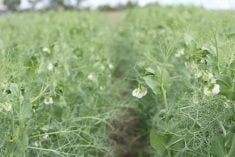Many durum growers avoided the Canadian Wheat Board’s fixed price contract because they considered the risk premium too high.
As a result, the board has revamped the contract and hopes to entice more farmers to use it – by increasing the size of the premium.
That may sound strange, but the FPC Plus contract will probably cost less because farmers will be eligible for a refund at the end of crop year after the board has seen whether all the premium money was eaten up by unexpected price moves and hedging costs.
Read Also

Phosphate prices to remain high
Phosphate prices are expected to remain elevated, according to Mosaic’s president.
“We’re going to take more discount up front, (but) now we’re going to share that risk with you, Mr. Farmer,” said Mel Pawlyk, who manages the wheat board’s Producer Payment Options program.
“You will be eligible for a rebate on your risk discount if the market situation at the end of the year warrants it. By doing that, ultimately you’re going to get a higher price than you would have under the old program.”
Pawlyk estimated the risk premium will increase by 10 to 15 percent.
The FPC has become popular with wheat growers who like being able to lock in a price and get their money up front rather than waiting for interim and final payments through the pool and taking the chance that prices will drop.
The wheat FPC can be easily hedged through the use of hard red spring wheat futures at the Minneapolis Grain Exchange and wheat contracts in Chicago and Kansas City. The Canadian dollar is also easily hedged.
Durum is a problem, however, because there is no durum futures contract and the markets and growing area are distinct from hard red spring wheat regions.
Pawlyk said the board can cross-hedge durum by using the Minneapolis wheat contract, but it’s an imperfect hedge that mainly protects against a market disaster.
Durum is grown in a much smaller zone than spring wheat, so local weather and production issues can have a big affect. As well, the markets are significantly different from the main world wheat markets, so moves in the wheat markets may not be reflected in durum prices, causing a significant hedging breakdown.
Without a real contract to use as a basis, the board has been forced to collect higher risk deductions than it does with wheat, which has discouraged farmers from using the durum FPC.
The money the board collects for risk was placed in the durum contingency fund and stayed there regardless of whether the premium was used, allowing the board to keep the discount lower than it would otherwise. However, the board now plans to pay back excess premiums, so it won’t have a surplus to fall back on if a contract moves in a large way.
That’s why the board will boost the premium up front but believes it may be more attractive than the old contract. The CWB hopes that farmers will understand they will likely receive a rebate at the end of the year and won’t believe they’re being overcharged.
“If there is a residual after cost and detainment … we’re going to give that back to you,” Pawlyk said.
The durum FPC runs from February to October.















